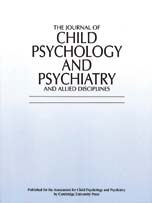Crossref Citations
This article has been cited by the following publications. This list is generated based on data provided by
Crossref.
Cunningham, C. C.
Glenn, S.
and
Fitzpatrick, H.
2000.
Parents telling their Offspring about Down Syndrome and Disability.
Journal of Applied Research in Intellectual Disabilities,
Vol. 13,
Issue. 2,
p.
47.
Mukaddes, N. M.
2002.
Gender identity problems in autistic children.
Child: Care, Health and Development,
Vol. 28,
Issue. 6,
p.
529.
Attwood, Tony
2003.
Frameworks for behavioral interventions.
Child and Adolescent Psychiatric Clinics of North America,
Vol. 12,
Issue. 1,
p.
65.
Glenn *, Sheila
and
Cunningham, Cliff
2004.
Self‐awareness in Young Adults with Down Syndrome: II. Self‐understanding.
International Journal of Disability, Development and Education,
Vol. 51,
Issue. 4,
p.
363.
Alvarez, Anne
and
Lee, Anthony
2004.
Early Forms of Relatedness in Autism: A Longitudinal Clinical and Quantitative Single-Case Study.
Clinical Child Psychology and Psychiatry,
Vol. 9,
Issue. 4,
p.
499.
Plesa-Skwerer, Daniela
Sullivan, Kate
Joffre, Kristen
and
Tager-Flusberg, Helen
2004.
Self concept in people with Williams syndrome and Prader–Willi syndrome.
Research in Developmental Disabilities,
Vol. 25,
Issue. 2,
p.
119.
Hobson, Peter
2005.
Handbook of Autism and Pervasive Developmental Disorders.
p.
406.
Hobson, R. Peter
and
Meyer, Jessica A.
2005.
Foundations for self and other: a study in autism.
Developmental Science,
Vol. 8,
Issue. 6,
p.
481.
Malti, Tina
2006.
Aggression, Self-Understanding, and Social Competence in Swiss Elementary-School Children.
Swiss Journal of Psychology,
Vol. 65,
Issue. 2,
p.
81.
Lee, Anthony
and
Peter Hobson, R.
2006.
Drawing self and others: How do children with autism differ from those with learning difficulties?.
British Journal of Developmental Psychology,
Vol. 24,
Issue. 3,
p.
547.
2006.
REFERENCES.
Monographs of the Society for Research in Child Development,
Vol. 71,
Issue. 2,
p.
155.
Hare, Dougal Julian
Mellor, Christine
and
Azmi, Sabiha
2007.
Episodic memory in adults with autistic spectrum disorders: Recall for self- versus other-experienced events.
Research in Developmental Disabilities,
Vol. 28,
Issue. 3,
p.
317.
García-Pérez, Rosa M.
Lee, Anthony
and
Hobson, R. Peter
2007.
On Intersubjective Engagement in Autism: A Controlled Study of Nonverbal Aspects of Conversation.
Journal of Autism and Developmental Disorders,
Vol. 37,
Issue. 7,
p.
1310.
Hobson, R. Peter
Lee, Anthony
and
Hobson, Jessica A.
2007.
Only connect? Communication, identification, and autism.
Social Neuroscience,
Vol. 2,
Issue. 3-4,
p.
320.
Lombardo, Michael V.
Barnes, Jennifer L.
Wheelwright, Sally J.
Baron-Cohen, Simon
and
Zak, Paul
2007.
Self-Referential Cognition and Empathy in Autism.
PLoS ONE,
Vol. 2,
Issue. 9,
p.
e883.
Crane, Laura
and
Goddard, Lorna
2008.
Episodic and Semantic Autobiographical Memory in Adults with Autism Spectrum Disorders.
Journal of Autism and Developmental Disorders,
Vol. 38,
Issue. 3,
p.
498.
Begeer, Sander
Banerjee, Robin
Lunenburg, Patty
Meerum Terwogt, Mark
Stegge, Hedy
and
Rieffe, Carolien
2008.
Brief Report: Self-Presentation of Children with Autism Spectrum Disorders.
Journal of Autism and Developmental Disorders,
Vol. 38,
Issue. 6,
p.
1187.
Williamson, Sara
Craig, Jaime
and
Slinger, Richard
2008.
Exploring the relationship between measures of self-esteem and psychological adjustment among adolescents with Asperger Syndrome.
Autism,
Vol. 12,
Issue. 4,
p.
391.
Bello, Katrina D
Goharpey, Nahal
Crewther, Sheila G
and
Crewther, David P
2008.
A puzzle form of a non-verbal intelligence test gives significantly higher performance measures in children with severe intellectual disability.
BMC Pediatrics,
Vol. 8,
Issue. 1,
García-Pérez, Rosa M.
Hobson, R. Peter
and
Lee, Anthony
2008.
Narrative Role-Taking in Autism.
Journal of Autism and Developmental Disorders,
Vol. 38,
Issue. 1,
p.
156.


